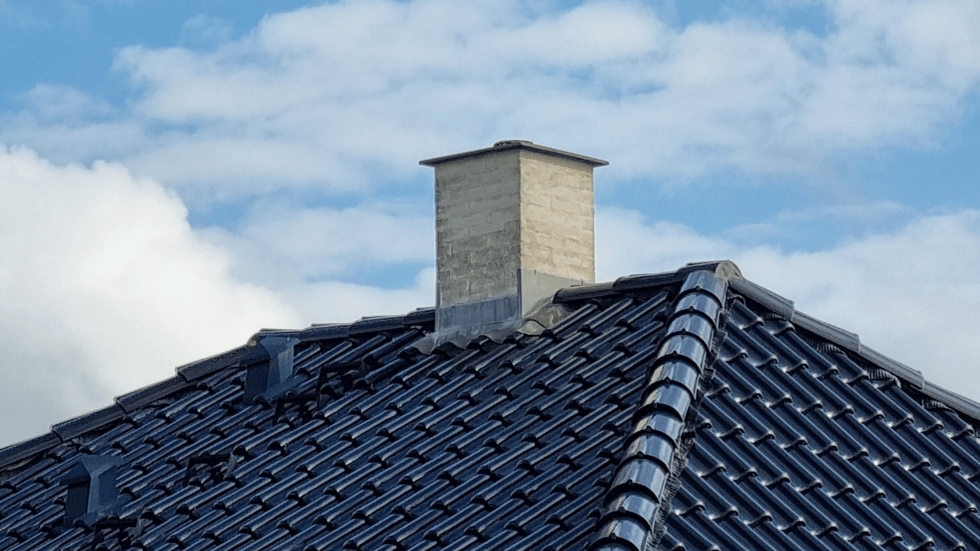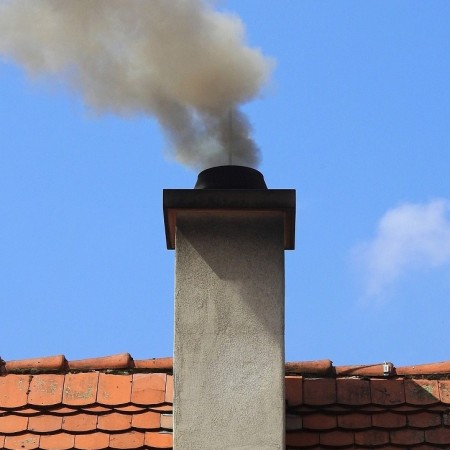The chimney’s most important function is to suck in enough air in the wood burning stove that you’ll get a good combustion process. If your chimney doesn’t fit your wood burning stove, you’ll get a bad chimney draft which will cause troubles when you light a fire, and there’ll be smoke in your living room, bad combustion and smoke development which will bother you and your neighbours.
Your chimney must be:
- Appropriately high
- Well-insulated (so the smoke won’t cool down and create tarry soot)
- Tight (check packages and clean-out door)
How to get a good chimney draft
The draft in your chimney is caused by the difference in temperature between the air and smoke inside the chimney and the outside temperature. Because of the temperature difference, an upgoing airstream will arise and it’ll get stronger the higher the chimney is and the better it’s insulated.
That’s why it can be an advantage to install a chimney which is easier to heat and which has a good insulation so it’ll keep in the heat better than a chimney made of only bricks.
The ideal chimney draft is between 12-15 pascal (Pa), but the pressure varies throughout the year. It’s highest in the winter and lowest during the summer. The draft also changes throughout the combustion process.
How to check the chimney draft
You can easily check yourself if the draft in your chimney is sufficient. Open the stove door a crack and hold a lighter or a match close to the door. A good chimney draft will suck the flame ‘into’ the combustion chamber.
The wood burning stove depends on the chimney
To make the most out of your wood burning stove, it’s important that your chimney functions the way it’s supposed to. It’s important to take the height of the chimney into consideration when you place a wood burning stove and a chimney in your house.
If your house is surrounded by tall trees or buildings that’ll also play a role when it comes to deciding the height of your chimney. The wind also plays a role because it can increase or reduce the draft. There’s a risk of smoke being pushed back into the chimney and into your house, especially if the chimney isn’t higher than the ridge or if there are tall trees close by. In these instances it might be a good idea to fix a smoke exhauster or a chimney fan to the chimney as it will prevent the wind from blowing down the chimney.
If you have a very big chimney, it might be a good idea to install a damper in the flue. This way you can adjust the draft in the chimney and you’ll get optimal combustion. A chimney draft which is too strong can make whistling sounds from the wood burning stove and it can cause too strong combustion.
The chimney must:
- Remove the smoke from the wood burning stove and conduct it outside.
- Conduct the smoke away so it won’t bother the people who live near you.
- Draw in enough air into the wood burning stove so combustion will be as clean as possible.
Placement of the chimney
The placement of the chimney on the roof determines the chimney draft. Below you’ll see the three zones in which the chimney can be placed and their importance.
Zone 1: Is the chimney placed in zone 1, you can be relatively sure that the chimney draft is good. The draft will though still be affected by big trees and other buildings close to the chimney.
Zone 2: Is the chimney placed in zone 2, you can experience that the chimney draft is not good in periods. The draft will especially be affected by the wind direction, while big trees and other buildings close to the chimney also can affect the draft. If you experience difficulties in zone 2, this can be rectified by extending the chimney to zone 1 or by installing a smoke exhauster.
Zone 3: Is the chimney placed in zone 3, you will experience that the chimney draft often is not good. In this case you should install a smoke exhauster to avoid difficulties.
Are you having problems with your wood burning stove?
If it’s difficult to light a fire or if there’s smoke in the living room when you open the stove door, it’s quite possible that your wood burning stove doesn’t meet the requirements.
One challenging aspect of this is that recently built houses are much better insulated than they were 10 years ago. New buildings are often low energy houses with ventilation systems and big cooker hoods that’ll compete about the air in the house with the chimney.
Possible solutions to a bad chimney draft
- Extend the chimney
- Make more room for air around the chimney by cutting down high trees
- Insulate or seal up cracks in the chimney
- Light a fire correctly so the temperature will rise fast
- Install a rotating chimney fan
- Install a smoke exhauster on the chimney
You can always ask your chimney sweep or contact your dealer if you have any troubles with the chimney.





